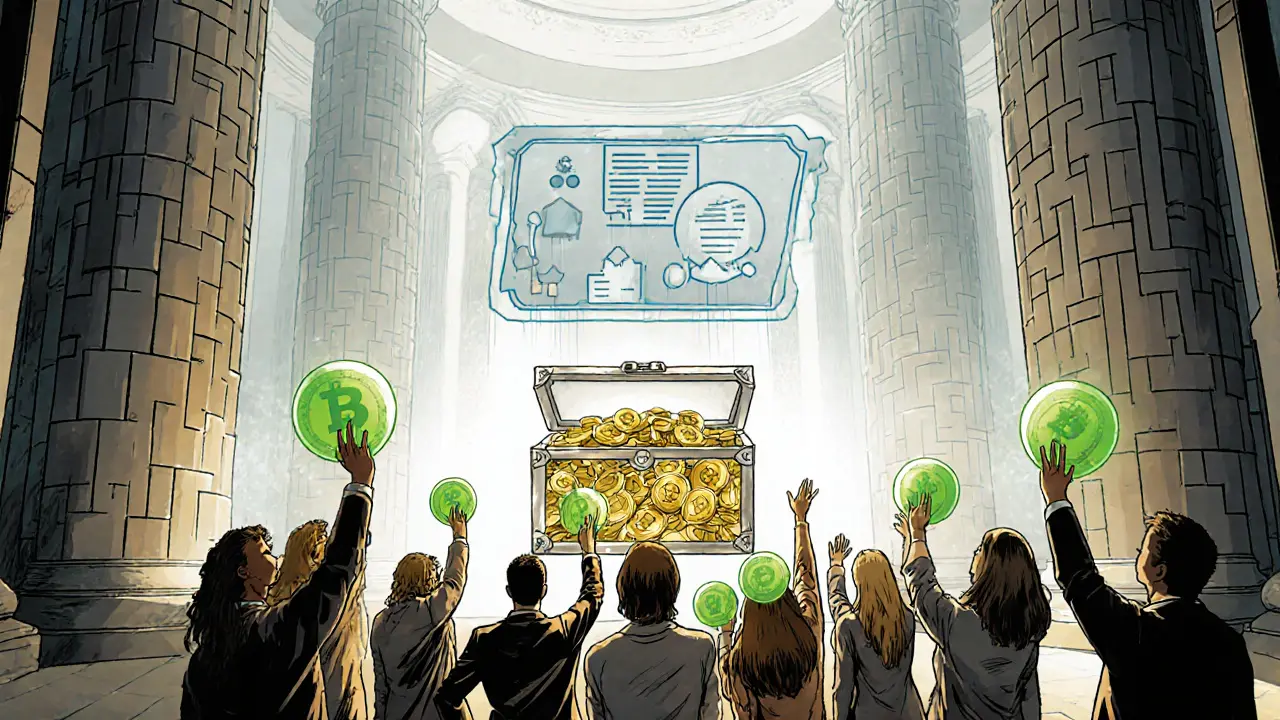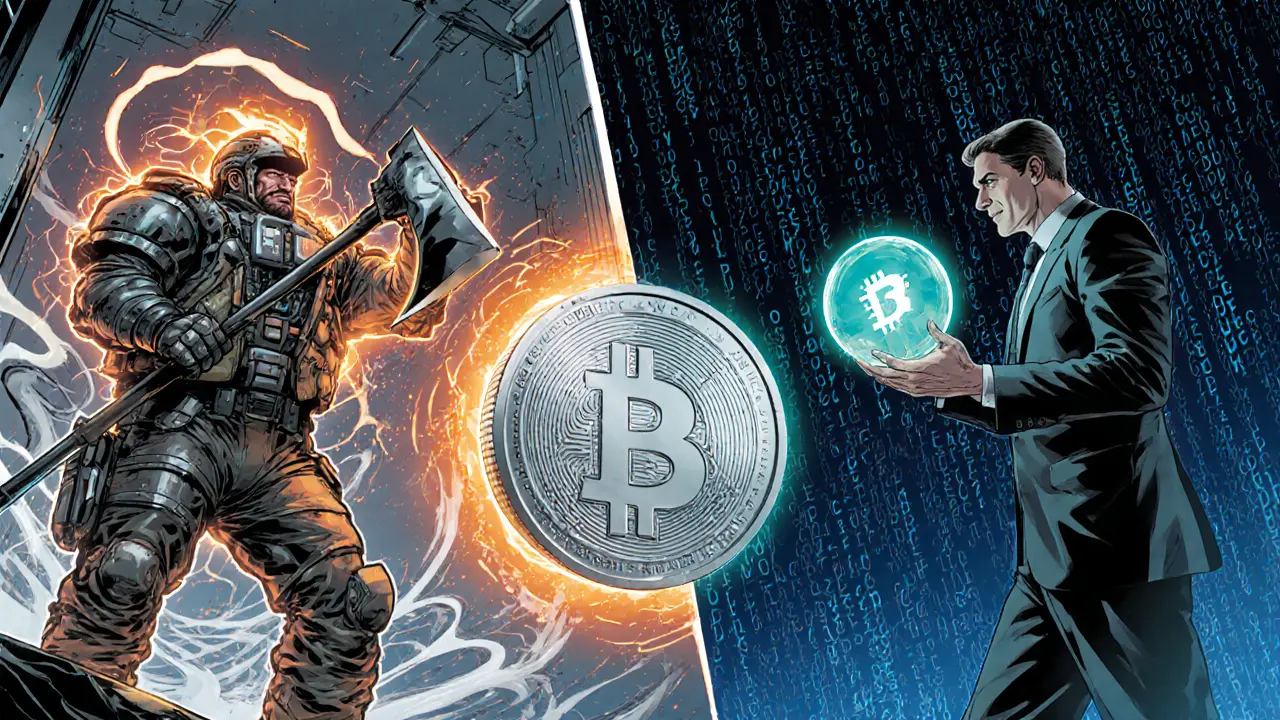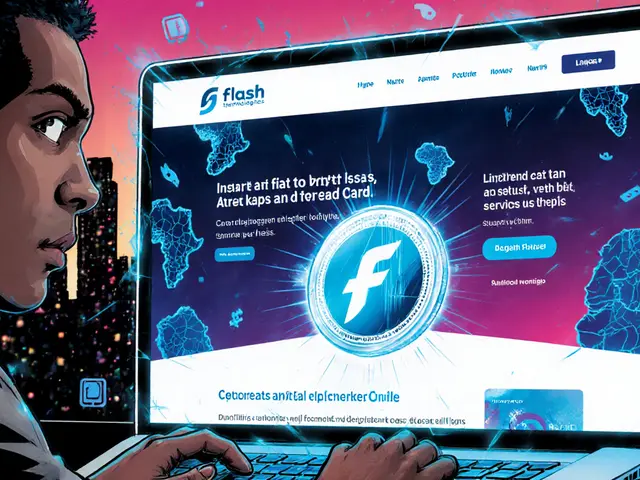Decred (DCR) Consensus Calculator
Reward Distribution Breakdown
How Decred's Hybrid Consensus Works
Proof-of-Work
Miners solve BLAKE-256 puzzles to secure the blockchain.
Proof-of-Stake
Stakers lock DCR as tickets to vote on blocks.
Security
Dual consensus makes 51% attacks extremely difficult.
Ever wondered why some crypto projects talk about voting, treasury funds, and a blend of mining and staking? Decred is the first coin that built all of that into its core. Launched in 2016 by a group of Bitcoin developers, Decred aims to give every holder a real say in the network while keeping the system secure and sustainable.
Key Takeaways
- Decred uses a hybrid Proof‑of‑Work/Proof‑of‑Stake (PoW/PoS) consensus called Proof‑of‑Activity.
- Stakers earn voting rights and a share of block rewards through the Politeia governance platform.
- A self‑funded treasury receives 10% of each block reward, ensuring continuous development without external investors.
- The total supply caps at 21million DCR, with 8% pre‑mined at launch.
- Decred’s ecosystem includes a Lightning Network implementation, a decentralized exchange (DEX), and atomic‑swap capability.
What is Decred?
Decred is an open‑source, community‑driven cryptocurrency that serves both as a digital cash system and a store of value. It was created by the same developers behind btcsuite, an alternative full‑node implementation of Bitcoin written in Go. The goal was simple: fix Bitcoin’s governance flaws by giving coin‑holders direct control over upgrades and spending.
Hybrid Consensus: Proof‑of‑Work + Proof‑of‑Stake
The heart of Decred’s security is its hybrid consensus, often called Proof‑of‑Activity. In practice this means two parallel processes:
- Miners solve Proof‑of‑Work puzzles using the BLAKE‑256 hash function. This secures the block chain against external attacks.
- Stakeholders lock up DCR as tickets, enabling Proof‑of‑Stake voting on each new block. If a malicious miner tries to rewrite history, the staked tickets can reject the block.
Because an attacker would need to control both the mining hash power and a majority of the staked tickets, a 51% attack becomes dramatically more expensive.
Governance Made Public with Politeia
Decred’s governance platform, Politeia, launched in 2018, acts as an open‑source proposal system. Anyone can submit a ticket‑backed proposal, pay a small fee, and let the community vote.
When a proposal passes, the treasury automatically allocates the requested funds. This creates a clear, on‑chain trail of how development money is spent, solving the so‑called “tragedy of the commons” that many DAOs face.
Self‑Funding Treasury
Each block reward is split three ways: 60% to miners, 30% to stakers, and 10% to the treasury. The treasury is controlled entirely by the voting process, meaning no venture capital, no ICO‑funded promises-just the community’s own resources.
This model has kept development steady through bull and bear markets, allowing the team to fund everything from core code work to marketing and community outreach.

Technical Specs You Should Know
- Supply cap: 21million DCR (8% pre‑mined at launch).
- Block time: ~5 minutes.
- Hash algorithm: BLAKE‑256, built on a HAIFA construction with ChaCha stream cipher tweaks.
- Programming language: Go (the same language behind Ethereum, Lightning Network, and many other projects).
- Subsidy decay: Exponential, but smoothed to avoid sudden market shocks.
Ecosystem Highlights
Decred isn’t just a coin; it’s a growing suite of tools:
- Lightning Network: Decred is one of the few PoW‑based chains actively developing Lightning support for instant, low‑fee payments.
- Decentralized Exchange (DEX): Built with atomic‑swap technology, the DEX lets users trade DCR for other coins without fees or KYC.
- Privacy options: Optional privacy layers are available, and the code is being audited for post‑quantum security.
How Decred Stacks Up Against Bitcoin and Ethereum
| Feature | Decred (DCR) | Bitcoin (BTC) | Ethereum (ETH) |
|---|---|---|---|
| Consensus | Hybrid PoW/PoS (Proof‑of‑Activity) | Pure PoW | Proof‑of‑Stake (post‑Merge) |
| Governance | On‑chain voting via Politeia | Informal, developer‑driven | Ethereum Foundation + EIP process |
| Funding Model | 10% treasury from every block | No built‑in treasury | Protocol‑level upgrades funded by ecosystem |
| Supply Cap | 21M DCR | 21M BTC | No hard cap |
| Layer‑2 Focus | Lightning Network development | Lightning Network (widely adopted) | Optimistic & ZK‑Rollups |
From this table you can see why Decred is often described as a “Bitcoin with governance”. It keeps the monetary scarcity of Bitcoin while adding a structured way for the community to decide on upgrades and spending.
Pros, Cons, and Who Should Care
Pros
- Strong security from dual consensus.
- Transparent, on‑chain funding ensures continuous development.
- Active Lightning and DEX projects provide real use‑cases.
- Clear voting rights for anyone who stakes DCR.
Cons
- Complexity: New users must understand both mining and staking.
- Liquidity is lower than Bitcoin or Ethereum, leading to higher price volatility.
- Governance participation rates, while decent, are still below 15% of total supply.
If you’re a crypto enthusiast who values decentralization and wants a stake in a network’s future, Decred is worth a look. If you prefer a simple buy‑and‑hold approach without dealing with tickets, you might stay with Bitcoin.
Getting Started with Decred
- Download a trusted wallet (e.g., Decrediton or Atomic Wallet).
- Buy DCR on a reputable exchange (Binance, Kraken, or decentralized DEX).
- If you plan to vote, lock a portion of your DCR as tickets via the wallet’s “Purchase Ticket” feature.
- Visit the Politeia site to see active proposals and maybe submit your own.
Remember, buying DCR is just the first step. To truly benefit from the ecosystem you’ll want to stake, vote, and maybe even run a Lightning node.
Frequently Asked Questions
What makes Decred’s consensus different from Bitcoin’s?
Bitcoin relies only on Proof‑of‑Work, meaning security comes solely from miners. Decred adds a Proof‑of‑Stake layer where ticket holders vote on each block. An attacker would need to control both the hash power and a majority of tickets, making attacks much harder.
How does the treasury fund work?
Every new block splits its reward: 60% to miners, 30% to stakers, and 10% to a treasury address. The treasury’s money can only be spent through approved Politeia proposals, ensuring community oversight.
Do I need to run a full node to participate?
No. You can stake using a lightweight wallet that connects to remote nodes. Running a full node gives you more control and helps the network, but it’s not required for basic participation.
Is Decred compatible with the Lightning Network?
Yes. The Decred team is actively developing a Lightning implementation that mirrors Bitcoin’s. Once live, users will enjoy near‑instant, low‑fee transactions while retaining full security.
Where can I trade Decred without fees?
The native Decred DEX uses atomic swaps, allowing fee‑free, KYC‑free peer‑to‑peer trades. You’ll need a wallet that supports the DEX and a counter‑party willing to swap.
Decred’s blend of hybrid consensus, on‑chain governance, and a built‑in treasury makes it a unique experiment in crypto design. Whether you’re looking for a secure store of value, a platform to vote on upgrades, or a developer-friendly ecosystem, Decred offers a lot to explore.





Kimberly Kempken
October 4 2025Honestly, the whole hype around Decred feels like a vanity project for people who think adding voting mushes up crypto like a salad.
Amy Harrison
October 4 2025Wow! This breakdown makes Decred feel way more approachable 😄. The hybrid consensus is actually pretty cool, and the treasury idea gives it real staying power! 🙌
Natalie Rawley
October 4 2025Okay, let me school you all: Decred isn’t just "another coin"-it’s the embodiment of governance on a blockchain, and the fact that 10% goes straight to a community‑run treasury is a game‑changer. If you ignore that, you’re basically missing the point entirely.
Scott McReynolds
October 4 2025Decred’s hybrid consensus mechanism represents a pivotal evolution in blockchain security architecture. By requiring both proof‑of‑work and proof‑of‑stake, the system compels any attacker to acquire a majority of the hash power *and* a majority of the ticket‑holding stake, dramatically raising the cost of a 51 % attack. This dual‑layer defense mirrors the philosophical principle that true security emerges from the interplay of independent forces, a concept rooted in classical balance theory. Moreover, the allocation of block rewards-60 % to miners, 30 % to stakers, and 10 % to the treasury-creates a self‑sustaining economic loop that funds development without external capital. The treasury's on‑chain governance via Politeia further decentralizes decision‑making, allowing token holders to vote on proposals directly, thus preventing the centralization pitfalls observed in many DAO structures. In practice, a stakeholder who purchases a ticket not only earns a share of the block reward but also gains voting rights, intertwining financial incentives with governance responsibilities. The result is a feedback loop where active participants are rewarded both economically and politically, fostering a healthier ecosystem. From a technical standpoint, the use of BLAKE‑256 as the PoW hash function offers resistance to ASIC dominance, while the PoS component leverages the same DCR stake, ensuring that the network’s security posture remains adaptable over time. Additionally, Decred’s commitment to developing a Lightning Network implementation showcases its dedication to scaling solutions without sacrificing security. The project’s roadmap, which includes atomic‑swap DEX capabilities and privacy layers, indicates a forward‑looking vision that aims to address both usability and confidentiality. Ultimately, Decred embodies a comprehensive approach where consensus, governance, and funding are architecturally intertwined, offering a compelling alternative to the monolithic models of Bitcoin and Ethereum.
Alex Gatti
October 4 2025Building on that, the Politeia platform essentially acts as a transparent ledger for all funding proposals, which means anyone can audit where the community’s money goes-no hidden backrooms.
John Corey Turner
October 4 2025One thing people often overlook is that Decred’s codebase is written in Go, which makes it easier for developers coming from other projects like Ethereum to contribute, boosting the talent pool.
Laurie Kathiari
October 4 2025It’s morally incumbent on us to support a crypto that actually gives power back to its users rather than lining the pockets of venture capitalists.
Matt Nguyen
October 4 2025Decred is just a fancy experiment.
Shaian Rawlins
October 4 2025I love how the community feels like a supportive family, always helping newcomers understand staking and voting. The step‑by‑step guides on the official site are super clear, and the Discord channel has folks ready to answer any question you might have. Plus, the fact that you can actually see where treasury funds go gives a sense of trust that’s rare in crypto.
Cathy Ruff
October 4 2025Everyone acting like Decred is the holy grail is ridiculous-look at the low liquidity and you’ll see it’s just another niche coin.
Marc Addington
October 4 2025Patriotic crypto fans should back Decred because it shows America’s tech can innovate beyond just Bitcoin.
Amal Al.
October 4 2025For anyone new, start with a small amount, lock it as tickets, and watch your voting power grow; it’s a great way to get involved without huge risk.
Katherine Sparks
October 4 2025Dear community, I would like to commend the developers for maintaining rigorous documentation standards, which greatly facilitates onboarding for new participants.
stephanie lauman
October 4 2025Before you get starry‑eyed, remember that the governance model can be gamed if a single entity accumulates a large ticket share; it’s not a perfect system.
Twinkle Shop
October 4 2025From a cultural perspective, Decred serves as a case study in how decentralized autonomous governance can be operationalized using on‑chain proposals, thereby creating a replicable framework for future blockchain projects.
Greer Pitts
October 5 2025Exactly, the modular design of Decred’s ecosystem encourages interoperability with other blockchain solutions, which is essential for the long‑term viability of decentralized finance.
Lurline Wiese
October 5 2025Yo, the lightning integration is gonna make DCR payments fast AF, can’t wait to see it in action!
Jenise Williams-Green
October 5 2025It’s infuriating to see so many people ignore the ethical implications of a treasury that’s controlled by a small voting elite; we need more transparency.
Kortney Williams
October 5 2025I understand the concerns raised about centralization of ticket ownership, and I think encouraging broader participation can mitigate that risk.
Adarsh Menon
October 5 2025Sure, because a 10% treasury slice is totally going to solve all funding problems-yeah right.
Taylor Gibbs
October 5 2025If you’re curious about how to run a node, the community wiki has a step‑by‑step tutorial that walks you through hardware requirements, syncing, and security best practices.
Rob Watts
October 5 2025Running a node is a rewarding experience that strengthens the network.
Bhagwat Sen
October 5 2025Looking at the current stats, I’d say setting up a DCR node is pretty straightforward if you follow the guide.
mukesh chy
October 5 2025Oh great, another "decentralized" project that secretly relies on an elite handful of ticket holders-how original.